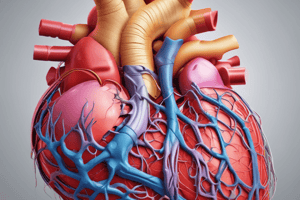Podcast
Questions and Answers
What is the end-diastolic volume of the left ventricle?
What is the end-diastolic volume of the left ventricle?
- 120 milliliters (correct)
- 70 milliliters
- 50 milliliters
- 140 milliliters
How is stroke volume calculated?
How is stroke volume calculated?
- End-diastolic volume divided by end-systolic volume
- End-systolic volume plus end-diastolic volume
- End-systolic volume minus end-diastolic volume
- End-diastolic volume minus end-systolic volume (correct)
What is the normal range for ejection fraction in a healthy individual?
What is the normal range for ejection fraction in a healthy individual?
- 70% to 75%
- 50% to 60%
- 58% to 65% (correct)
- 40% to 50%
What is the cardiac output of an individual with a stroke volume of 70 ml/beat and a heart rate of 70 beats/minute?
What is the cardiac output of an individual with a stroke volume of 70 ml/beat and a heart rate of 70 beats/minute?
Which organ receives the largest amount of blood flow?
Which organ receives the largest amount of blood flow?
What is the formula to calculate cardiac output?
What is the formula to calculate cardiac output?
What does an ejection fraction measure?
What does an ejection fraction measure?
Which organ receives the largest amount of blood flow?
Which organ receives the largest amount of blood flow?
What is stroke volume?
What is stroke volume?
How does cardiac output change during exercise?
How does cardiac output change during exercise?
Flashcards are hidden until you start studying
Study Notes
The Heart's Function
- Main role is to pump oxygenated blood with nutrients through arteries to tissues and return deoxygenated blood through veins.
Left Ventricle Characteristics
- End-diastolic Volume (EDV): At relaxation, approximately 120 milliliters of blood is present in the left ventricle.
- End-systolic Volume (ESV): After contraction, approximately 50 milliliters remain in the left ventricle.
- Stroke Volume (SV): Calculated as EDV minus ESV, resulting in a stroke volume of 70 milliliters per heartbeat.
Stroke Volume Variability
- Stroke volume can differ based on body size; 50 milliliters may be adequate for a small person but low for a larger individual.
Ejection Fraction
- Ejection Fraction (EF): Represents the percentage of blood pumped from the left ventricle per heartbeat, calculated as stroke volume (70 ml) divided by end-diastolic volume (120 ml), resulting in about 58%.
- Normal ejection fraction ranges between 50% and 65%. Below 50% indicates low contractility.
Cardiac Output
- Cardiac Output (CO): Total blood volume ejected by the left ventricle per minute, calculated by multiplying stroke volume by heart rate.
- Example: With a stroke volume of 70 ml/beat and heart rate of 70 beats/min, CO equals 4900 ml/min (4.9 liters/min).
- An adult body contains approximately 5 liters of blood, implying complete circulation through the left ventricle every minute.
- The heart can adapt both heart rate and stroke volume based on activity levels, with trained athletes achieving up to 35 liters/min.
Blood Distribution
- Cardiac output is distributed to organs based on their oxygen and nutrient needs.
- Liver: Receives the largest blood flow.
- Kidneys: Receive significant flow but less than the liver, yet display high tissue perfusion based on mass—more blood per gram than other organs.
- Distinction between flow (total blood volume over time to an organ) and perfusion (blood volume per gram of tissue over time).
Summary of Key Metrics
- Stroke Volume: Volume of blood pumped with each heartbeat (EDV - ESV).
- Ejection Fraction: Percentage of blood pumped out with each heartbeat; measure of contractility.
- Cardiac Output: Volume of blood pumped in one minute, calculated as stroke volume multiplied by heart rate.
Studying That Suits You
Use AI to generate personalized quizzes and flashcards to suit your learning preferences.




